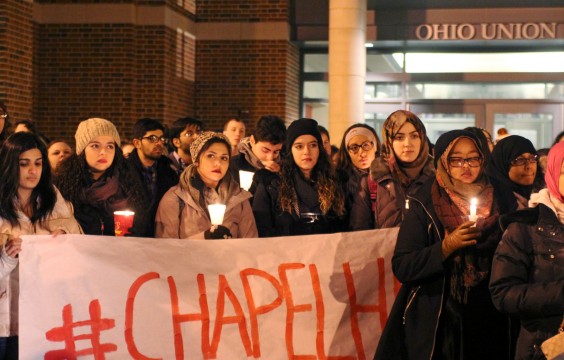“Today, I wrap my hijab a little tighter,” said Jana Al-Akhras, a first-year law student at Ohio State, while reciting a poem at a candlelight vigil in honor of three Muslim students, who were killed earlier this week.
The students were fatally shot, allegedly by a neighbor, in Chapel Hill, N.C., on Tuesday.
One student attended the University of North Carolina-Chapel Hill, another attended North Carolina State University and the third had plans to attend UNC-Chapel Hill in the fall.
The front of the Ohio Union was illuminated by candlelight Wednesday night, as about 100 OSU students, faculty and community members honored 23-year-old Deah Barakat, his wife, 21-year-old Yusor Abu-Salha, and her sister, 19-year-old Razan Abu-Salha.
But the candlelight illuminated more than the front of the building. It shone on faces filled with pain, covered with tears, expressing the frustration, anger and confusion of almost each person standing in the cold.
Growing up as a Muslim in the post-9/11 world is not easy. Especially when the post-9/11 world is all you remember.
“I was angry,” said Mushtaq Dualeh, a fourth-year in public health development studies. “Our entire lives, we have been dealing with discrimination and hatred. I didn’t do anything, you didn’t do anything, they didn’t do anything, but they are still victims.”
Whether you look Muslim or not, growing up in a world that consistently makes you feel guilty for belonging to a beautiful religion that very few people twist in order to achieve their evil missions is not easy.
“I shed a tear for every Muslim who had to apologize, for every misguided soul who made a choice in the name of my religion,” Al-Akhras said. “For the media that reported it and neglected to draw a distinction, for those who believed them and looked at me strangely that day.”
As everyone stood in a circle, and people walked to the middle, one by one, to hold up a megaphone and express their emotions, something hit me as I looked at the pool of sad faces in front of me.
We have been bottling it up for years. We have been bottling up that emotion, pain, frustration, stress. And the shock of Tuesday night’s traumatic event hit us all and cracked the bottle open. We were all a mess of shattered glass.
For the first time, none of us felt safe. Or, at least, we confronted that reality for the first time.
“We resonate with those people because they’re just like us,” Dualeh said. “They’re Muslim, they’re students, they’re dreamers, they’re thinkers.”
It could have been us.
Yet even in the frigid Ohio winter, there was a warmth amongst the crowd of Muslims, Jews, whites, blacks and browns. Because in that moment, we weren’t all from our own little group of similar colors and faiths. In that moment, we were all American, and we were all human.
As we stood and supported each other, as tears streamed down our faces, as our hearts swelled with pain, empathy and compassion, I still felt a warmth. Because I wasn’t alone. None of us were alone.
Extremists can slay and contort the beauty of Islam. The media can fail to shed light on the truth about my religion, and fail to educate their audience enough to realize that religion is not the root of all evil. People can discriminate, hate and fear.
At the end of the day, there are more than 1.6 billion Muslims in this world. And if the majority of us did not follow Islam as the pure, peaceful and loving religion it truly is, the world wouldn’t be the way it is today.
But more importantly, at the end of the day, we are not alone. We will face the manipulation, hate and fear together. We will bear the burden together, and we will stand strong, along with the billions of other loving, understanding and educated people in this world.
Prophet Muhammad, may peace be upon him, once said, “You do not do evil to those who do evil to you, but you deal with them with forgiveness and kindness.”
I urge everyone to keep this in mind as they continue the walk of life, and drive out hate with love.
Clarification: Feb. 12, 2015
An earlier version of this article implied that the three students who were killed attended University of North Carolina-Chapel Hill, when in fact, one of them attended UNC, one attended North Carolina State University and one had plans to begin attending UNC in the fall.
Correction: Feb. 12, 2015
An earlier version of the photo captions in the gallery with this article said the three students who were killed attended University of North Carolina-Chapel Hill, when in fact, only one of them was a current student at UNC.








